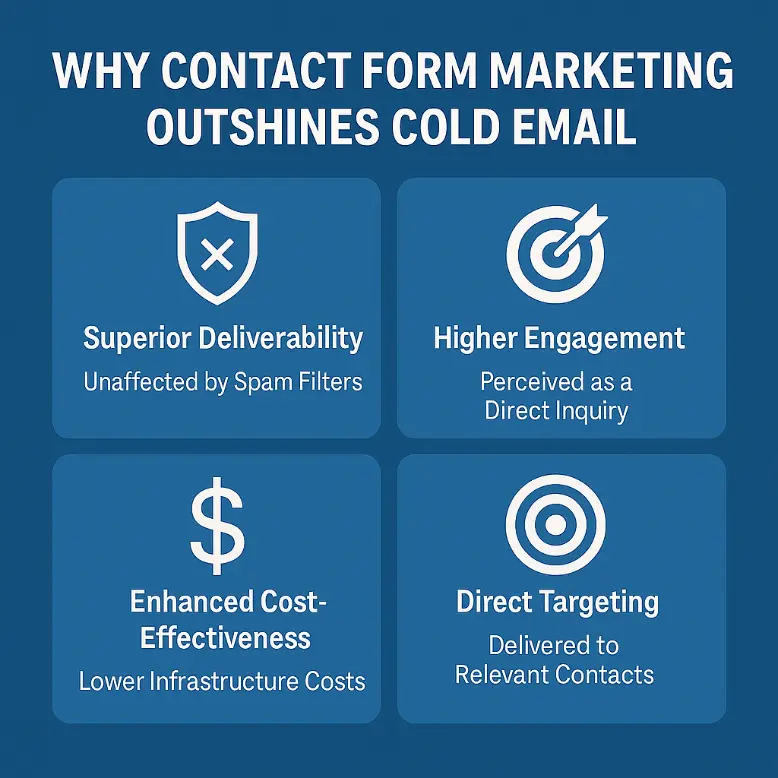Contact Form Marketing: The Direct Route to High-Value Leads

In the relentless pursuit of customer acquisition and business growth, marketers are constantly seeking more effective and efficient ways to connect with target audiences.1 Traditional methods like cold emailing, while scalable, often grapple with diminishing returns due to saturated inboxes, aggressive spam filters, and low engagement rates.2 Enter contact form marketing, a strategic approach that leverages a company’s own website contact forms to deliver targeted messages directly, proving to be a potent, cost-effective alternative for generating high-quality leads.
This comprehensive guide delves into the intricacies of contact form marketing, exploring its mechanisms, benefits, and best practices, all while underscoring why it’s gaining traction as a superior outreach strategy.
What Exactly is Contact Form Marketing?
At its core, contact form marketing is the practice of sending personalized, relevant messages to businesses or individuals by submitting them through the contact forms on their official websites. Instead of trying to find individual email addresses and battling spam filters, this method utilizes a direct, existing channel that organizations have set up for receiving inquiries.
Think of it as a highly targeted, digital version of a direct mail piece that lands right on the relevant “desk” within a company. The message isn’t just another cold email lost in a sea of unread correspondence; it’s an inquiry submitted via the company’s own designated communication portal. This inherent difference often leads to significantly higher visibility and consideration.
While it shares the proactive outreach nature of cold email, contact form marketing distinguishes itself through its delivery mechanism, which in turn influences its effectiveness and perception.

The Mechanics: How Contact Form Submissions Work for Outreach
Most business websites feature a “Contact Us” page with a form.3 These forms are designed to capture inquiries, feedback, or service requests.4 When a message is submitted through a contact form:
- Data Capture: The website’s backend system collects the information entered into the form fields (name, email, message, etc.).
- Notification/Routing: This information is typically emailed to a pre-designated email address (e.g., [email protected], [email protected], or a specific department/individual). Sometimes, it’s also stored in a database connected to the website or a CRM system.5
- Internal Handling: The message is then processed internally like any other inquiry received through the website.
Contact form marketing taps into this existing infrastructure. Instead of sending an email to an address, you’re using the website’s functionality to send a message from their own system to their designated point of contact.
Why Contact Form Marketing Outshines Traditional Cold Email
The advantages of contact form marketing over conventional cold emailing are compelling, primarily centering on deliverability, engagement, and cost-efficiency.
1. Superior Deliverability:
- Unaffected by Spam Filters: Cold emails are notorious for triggering spam filters.6 Complex algorithms analyze sender reputation, email content, sending volume, and recipient engagement to weed out unsolicited mail.7 Messages sent via contact forms, however, originate from the website itself or are relayed by its server. These are typically whitelisted or treated with high priority by the recipient’s email system, ensuring they land in the primary inbox, not the spam folder.
- Reaching the Right Inbox: Contact forms are usually configured to send submissions to specific individuals or departments responsible for handling inquiries (e.g., sales, marketing, partnerships, customer support). This means your message is more likely to reach someone relevant, rather than a generic, unmonitored email address or an employee who isn’t the right contact person.
2. Higher Engagement Rates:
- Perceived as a Direct Inquiry: A message received through a company’s own contact form is often perceived as a proactive inquiry from a potential customer or partner, rather than an unsolicited sales pitch. This psychological distinction can lead to higher open rates and more thoughtful consideration of the message content.
- Increased Urgency and Attention: Businesses generally prioritize communications received through their official channels. There’s an implicit understanding that someone took the time to visit their website and use their designated form, signaling a potentially serious intent.
- Reduced “Cold Outreach” Stigma: While the outreach is technically “cold” in that there’s no prior relationship, the delivery method feels less intrusive and more aligned with how the company has chosen to receive communications.
3. Enhanced Cost-Effectiveness:
- Lower Infrastructure Costs: Effective cold emailing often requires significant investment in multiple domains, IP warming services, specialized sending software, and continuously updated email lists to maintain deliverability and avoid blacklisting. Contact form marketing can reduce or eliminate many of these overheads.
- No Need for Mass Email List Procurement: While identifying target websites still requires effort, it bypasses the often costly and unreliable process of purchasing mass email lists, many of which contain outdated or irrelevant contacts.
- Potentially Higher ROI: Due to improved deliverability and engagement, the conversion rate from message sent to positive response or lead generated can be significantly higher. This means a better return on investment, even if the volume of messages sent is lower than a mass cold email campaign.
4. Direct Access and Targeting:
Contact form marketing allows for precise targeting of companies based on industry, size, location, or other specific criteria identified through website analysis. The message is delivered directly into their operational workflow.
Strategic Applications of Contact Form Marketing
The versatility of contact form marketing makes it suitable for a variety of B2B outreach goals:
- B2B Lead Generation: Introduce your products or services to companies that fit your ideal customer profile.
- Partnership and Collaboration Inquiries: Propose joint ventures, affiliate relationships, or co-marketing opportunities.
- PR and Media Outreach: Share newsworthy stories, press releases, or expert insights with relevant publications or journalists via their website forms.
- Link Building and SEO: Request guest posting opportunities or suggest resource collaborations to website owners.
- Recruitment: In some cases, for highly specialized roles, reaching out to companies that might have suitable (but not actively looking) candidates.
- Feedback and Research: Gather targeted industry feedback or conduct market research by reaching out to specific types of businesses.
Best Practices for Ethical and Effective Contact Form Marketing
To maximize the benefits of contact form marketing and maintain a positive reputation, it’s crucial to approach it ethically and strategically:
- Thorough Targeting:
- Identify the Right Companies: Don’t take a shotgun approach. Research and identify businesses for whom your message and offering are genuinely relevant and valuable.
- Understand Their Needs: Briefly visit the target website to understand their business. This allows for better personalization.
- Craft Compelling, Concise Messages:
- Clear Value Proposition: Get straight to the point. Clearly articulate who you are, what you offer, and why it should matter to them.
- Personalization (Where Possible): Address the company or the relevant department. Generic messages are less effective. Mention something specific about their business if appropriate.
- Brevity is Key: Contact form message boxes often have character limits, and recipients appreciate concise communication. Avoid lengthy, rambling pitches.
- Professional Tone: Maintain a respectful and professional tone. You are representing your brand.
- Provide Valid Contact Information:
- Always use your legitimate business email address and name. Transparency builds trust. Using temporary or fake emails will quickly undermine your efforts and can be perceived as spam.
- Clear Call to Action (CTA):
- What do you want them to do next? Visit your website? Schedule a brief call? Request more information? Make your CTA clear and easy to follow.
- Respect and Professionalism:
- Do Not Spam: This method is powerful, but if misused, it can be just as annoying as email spam. Focus on quality over quantity.
- Avoid Over-Automation (or Ensure it’s Sophisticated): While automation tools can assist in submitting forms, ensure they can handle nuances like different form structures and basic CAPTCHAs. Poorly executed automation can lead to errors and a negative impression.
- Honor “Do Not Contact” or Unsubscribe Implied Wishes: If a company indicates they are not interested, respect their decision.
- Compliance and Legal Considerations:
- Be mindful of data privacy regulations in your target regions. While contact forms are generally for inbound inquiries, proactive use requires ethical considerations. Ensure your messaging is not deceptive or misleading.
Navigating Potential Challenges
While highly effective, contact form marketing is not without its challenges:
- CAPTCHAs and Security Measures: Many websites use CAPTCHAs (Completely Automated Public Turing test to tell Computers and Humans Apart) to prevent automated spam.8 Manual submission or sophisticated automation is required to bypass these.
- Varying Form Structures: Contact forms are not standardized. Fields, layouts, and requirements differ from site to site, making large-scale manual submission time-consuming and automated submission complex.
- Message Length Limitations: Some forms have strict character limits, requiring very concise messaging.
- Perception if Done Poorly: A poorly targeted, generic, or overly aggressive message can still be perceived negatively, regardless of the delivery method.
- Tracking Limitations: Unlike email marketing with its open and click-through rates, directly tracking the “open rate” of a contact form submission is generally not possible. Success is typically measured by response rates and lead quality.
The Future of Direct Business Outreach
As businesses become increasingly adept at filtering out digital noise, innovative strategies that offer a more direct and respectful line of communication will continue to gain prominence. Contact form marketing, when executed thoughtfully and ethically, represents a significant step in this direction. It leverages existing infrastructure to bypass common barriers, ensuring your message not only gets delivered but also receives the attention it deserves.
By focusing on providing genuine value and respecting the recipient’s preferred communication channels, contact form marketing offers a powerful avenue to cut through the clutter, initiate meaningful conversations, and ultimately drive business growth in a more effective and often more economical way than traditional cold outreach methods. As with any marketing tactic, the key lies in a strategic, personalized, and value-driven approach.
References:
- inisoftglobal.com: https://inisoftglobal.com/blog/four-forces-reshaping-marketing (Article: Four Forces Reshaping Marketing: Navigating the New Landscape)
- Growleady: https://www.growleady.io/blog/cold-emailing-pros-cons-and-effectiveness-decline (Article: Cold Emailing: Pros, Cons, and Effectiveness Decline | Growleady)
- Forbes: https://www.forbes.com/councils/forbesbusinesscouncil/2023/08/11/19-essential-elements-every-business-website-needs/ (Article: 19 Essential Elements Every Business Website Needs – Forbes)
- Search Engine Journal: https://www.searchenginejournal.com/examples-contact-us-pages/378518/ (Article: Contact Us Page Examples: 44 Designs For Inspiration – Search Engine Journal)
- Act-On Connect Home: https://connect.act-on.com/hc/en-us/articles/360023759414-Push-Form-Data-to-a-CRM (Article: Push Form Data to a CRM – Act-On Connect Home)
- Kondo: https://www.trykondo.com/blog/cold-email-spam-triggers-what-you-need-to-know (Article: Cold Email Spam Triggers: What You Need to Know – Kondo)
- CMSWire.com: https://www.cmswire.com/digital-marketing/7-factors-that-determine-email-deliverability/ (Article: 7 Factors That Determine Email Deliverability – CMS Wire)
- DataDome: https://datadome.co/guides/captcha/what-is-captcha-and-how-does-it-work/ (Article: What is a CAPTCHA & how does it work? Types & Examples – DataDome)

